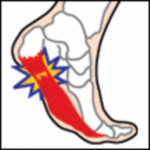· Your heels hurt or burn when you get out of bed in the morning, or after prolonged sitting.
· The pain often comes during cardio exercise, or the day after.
· The pain can be so bad, that every step hurts.
· The pain may extend along the outer sides of the feet; your feet feel “on fire.”
· No matter what you do, the flare-ups of pain persist, and sometimes come for no apparent reason.
These are classic symptoms of plantar fasciitis. The plantar fascia is a ligament-like band of tissue along the bottom of the foot, attaching to the heel bone and extending to the ball of the foot. Pain or a burning sensation-sometimes to the point of debilitation-occurs when this tissue becomes inflamed or tightens up.
Risk factors for plantar fasciitis (PF):
1. Improperly-fitting shoes, or inappropriate footwear for the activity at hand. PF is relatively common among athletes or people who do a lot of aerobic activity. Just because a gym shoe feels comfortable doesn’t mean it provides adequate arch support. Check the insoles of your gym or hiking shoes. Are they flat? Or is there a “bump” where the arch of your foot goes (for arch support)?
2. Improper biomechanics while wearing shoes with poor arch support. Example: Doing jumping drills in gym shoes that have no “bump.”
3. Fallen arches or flat feet
4. Being overweight
5. Tight calf muscles
Treatment for PF
· Do not attempt to “work through” the pain! If a flare-up occurs while exercising, immediately stop. If this means stepping off a cardio machine smack in the middle of your program, then so be it.
· Never engage in cardio activity unless you are pain-free. Cycling is great because it eliminates heel impact, and promotes a calf and arch stretch.
· Another great cardio activity-but only while you are pain-free-is hiking, especially uphill. The lumpy, bumpy and ever-changing terrain causes the fascia to stretch and pull in all directions, which off-sets the tightening that causes some of the pain.
· Accept the fact that you may have to limit your cardio routines to strictly cycling for many months. Lay off the running, power walking and step classes. Gradually resume only when you’ve gone two or three months with only a handful of flare-ups. Back off again if flare-ups increase in frequency.
·. There are tons of these on the market, and some are cheaply made and not very effective. Drug stores sell various arch supports, but footcare stores sell the higher-quality ones. There are also many heel-support devices and gadgets sold in footcare catalogues. Go with arch supports that are rigid. You may need to experiment with different brands before finding the right ones. The high-quality ones are pricey, but you get what you pay for.
· Before you get out of bed every morning, gently pull your toes (all at once) toward your knee to stretch the bottom of your foot. Even though you’ll feel the stretch primarily in the ball, this action also targets the heel area. While you sleep, the plantar fascia becomes tight. So when you walk first thing in the morning, the untightening is what causes the pain. By first stretching-three sets at 45 seconds to one minute-you prepare the fascia for walking. Do this stretch several times daily as well.
· Stretch your calves several times daily, especially before and after exercise.
· Wear shoes with good arch supports as much as possible; put the slippers and sandals in the back of the closet.
· Be patient. PF is by nature a stubborn condition that must run its course. It may take up to one year to resolve.
· You may also wish to consider getting a mold of your arches made by a foot specialist (podiatrist). These custom-made insoles, also known as orthotics, are very effective, and replace the insoles that come with all shoes. Footcare catalogues sell home-kit foot molds, but it’s far better to have a podiatrist examine your feet and do the molding.
·.
·. Never do a lot of the steps in dress boots, sandals, slippers, flip-flops, stilettos or pumps, especially if you have even one risk factor for PF.
Sandals are especially bad for people with a high-arched, or flat foot. Sandals do not provide longitudinal support, and this can mean potential stress to the plantar fascia.
Even if you have no risk factors, wearing high-heeled shoes (especially spike heels) can still cause problems, such as shortening of the Achilles tendon. They also increase stress to the ball of the foot. This can lead to bursitis, synovitis (inflammation of joint fluid) and even nerve irritation. Even lower-heeled dress shoes, including men’s professional footwear, can lead to arch strain, tendonitis and PF.
If you’d like to wear heels (who doesn’t want to appear taller?), they should be no more than 2 inches. For people who insist on sandals, ask a podiatrist about custom-made sandals, in which arch supports are crafted right into the body of the sandal.
Don’t wait until the first sign of PF appears. You can’t imagine how dreadful it is to have to give up running, hiking and jumping until it actually happens. Foot problems can be prevented.

